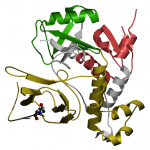Innovation in Nanotechnology will lead to improved drug delivery, diagnostics & imaging
Innovation in drug delivery presents opportunities for biotechnology companies, and is an area I expect we will see major leaps forward through nanotechnology.
Nanotechnology is the application of science and engineering to materials that are between 1 and 100 nanometers (nm) in size. The Environment Protection Agency (EPA) defines nanotechnology as “the creation and use of structures, devices, and systems that have novel properties and functions because of their small size.”
1nm is one-billionth of a meter. To put this in context, 1nm is one seven-thousandth of the width of a red blood cell or one eighty-thousandth of the width of a human hair. These are unimaginably small materials that are engineered to operate at the molecular and atomic level.
What’s more, there are now more than 1000+ consumer products on the market that utilize nanotechnology from the titanium particles in sunscreens to the silver contained in advanced first aid strips/plasters. Nanotechnology will impact more than $2.5 trillion of manufactured goods by 2015.
Lux Research predicts that by 2014, 16% of manufactured goods in healthcare and life sciences will include nanomaterials.
To date, the United States leads the way in the fast evolving field of nanotechnology. Between 2001 and 2010, the U.S. Government invested $12.4 billion in nanoscale science, engineering and technology through the U.S. National Nanotechnology Initiative (NNI).
The National Cancer Institute’s “NCI Alliance for Nanotechnology in Cancer” has an excellent website that outlines the potential impact of nanotechnology.
Some of the promising new cancer diagnostics and therapies based on nanotechnology include:
- Positron Emission Tomography (PET) imaging agents that can be used to assess the responsiveness of tumors to chemotherapy
- Chemically engineered adenovirus nanoparticle that stimulates the immune system. This is in phase 1 trials for chronic lymphocytic leukemia (CLL).
- Cyclodextrin-based nanoparticle that encapsulates a small-interfering RNA (siRNA) agent that shuts down a key enzyme in cancer cells
- CRLX101, a cyclodextrin-based polymer conjugated to camptothecin is in clinical trials with solid tumor patients
- A nanoparticle based magnetic resonance imaging (MRI) contrast agent that binds to αvβ3-intregrin, a protein found on newly developed blood vessels associated with tumor development. This is in early clinical trials
- Technology for the detection of cancer biomarkers such as prostate specific antigen (PSA)
- Use of carbon nanotubes to improve colorectal cancer imaging.
Emerging companies such as Bind Biosciences are focusing on targeting cancer, inflammatory, cardiovascular diseases and infectious diseases with therapeutic nanoparticles. Their lead product BIND-014 is currently in phase 1 development.
Innovations in nanotechnology will continue to present new product opportunities for biotechnology, pharmaceutical, medical imaging and diagnostics companies, and should be on everyone’s radar.
